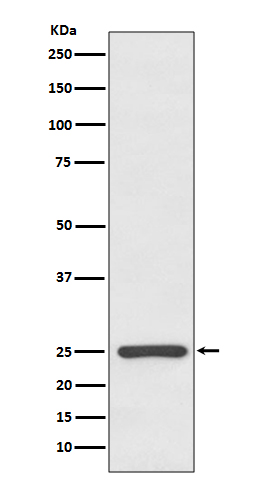
| WB | 1/500-1/1000 | Human,Mouse,Rat |
| IF | 1/20 | Human,Mouse,Rat |
| IHC | 1/50-1/100 | Human,Mouse,Rat |
| ICC | 1/50-1/200 | Human,Mouse,Rat |
| FCM | 咨询技术 | Human,Mouse,Rat |
| Elisa | 咨询技术 | Human,Mouse,Rat |
| Aliases | HCAK1; Ig kappa chain C region; IGKC; IMMUNOGLOBULIN InV; Km |
| Entrez GeneID | 3514 |
| WB Predicted band size | Calculated MW: 12 kDa; Observed MW: 25 kDa |
| Host/Isotype | Rabbit IgG |
| Antibody Type | Primary antibody |
| Storage | Store at 4°C short term. Aliquot and store at -20°C long term. Avoid freeze/thaw cycles. |
| Species Reactivity | Human |
| Immunogen | A synthesized peptide derived from human Kappa light chain |
| Formulation | Purified antibody in PBS with 0.05% sodium azide. |
+ +
以下是关于人类kappa轻链抗体的3篇代表性文献及其摘要概括:
---
1. **"Structural basis of antibody diversity: amino acid sequences of kappa chains"**
*作者:Kabat, E.A., Wu, T.T., Bilofsky, H. (1979)*
**摘要**:通过分析人类kappa轻链的氨基酸序列,揭示了其可变区(Vκ)和恒定区(Cκ)的结构特征,阐明了抗体多样性的遗传基础,为理解抗原结合特异性和免疫应答机制提供了关键数据。
2. **"Serum free light chain analysis in the diagnosis and management of multiple myeloma"**
*作者:Bradwell, A.R., et al. (2003)*
**摘要**:提出了一种新型免疫检测方法(ELISA),用于定量血清中游离kappa和lambda轻链,显著提高了多发性骨髓瘤的早期诊断准确性,并用于监测治疗反应和疾病复发。
3. **"Monoclonal gammopathy of undetermined significance (MGUS) and smoldering multiple myeloma: immunoglobulin free light chain assays and clinical outcomes"**
*作者:Kyle, R.A., et al. (2006)*
**摘要**:通过长期队列研究,证实血清游离kappa轻链水平异常可作为MGUS向多发性骨髓瘤转化的预测指标,强调了kappa轻链检测在临床预后评估中的重要性。
---
**备注**:上述文献涵盖了kappa轻链的结构基础、临床检测方法及疾病应用,均为该领域经典研究。如需具体文章细节或近年研究,建议通过PubMed/Google Scholar检索关键词(如“kappa light chain antibody”、“clinical applications”)。
Human kappa light chain antibodies are integral components of immunoglobulins, contributing to antigen recognition and immune response diversity. In humans, antibodies consist of two heavy chains and two light chains, with light chains existing as either kappa (κ) or lambda (λ) types. Approximately 60% of human antibodies contain kappa light chains, encoded by the IGK locus on chromosome 2. Each kappa chain comprises a variable (VL) and constant (CL) domain. The VL domain undergoes V(D)J recombination during B-cell development, generating vast antigen-binding diversity, while the CL domain maintains structural stability.
Kappa light chains pair with heavy chains to form antigen-binding sites, enabling specific recognition of pathogens. Their production is tightly regulated, with normal serum levels ranging from 3.3-19.4 mg/mL. Elevated free kappa chains (Bence Jones proteins) in serum or urine often indicate plasma cell disorders like multiple myeloma or monoclonal gammopathy. The κ:λ light chain ratio (normally 1.5:1 to 3:1) serves as a diagnostic marker for clonal B-cell expansions and renal impairment.
Clinically, anti-kappa antibodies are used in immunohistochemistry and flow cytometry to identify B-cell malignancies or monitor minimal residual disease. In research, they facilitate studies of B-cell receptor signaling and antibody engineering. Therapeutic applications include bispecific antibodies and CAR-T therapies, where kappa chain detection helps assess treatment efficacy. Their specificity and conserved structure make them valuable tools in both diagnostic and experimental immunology.
×